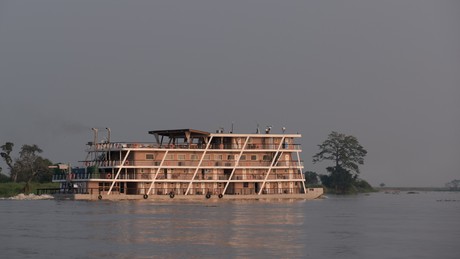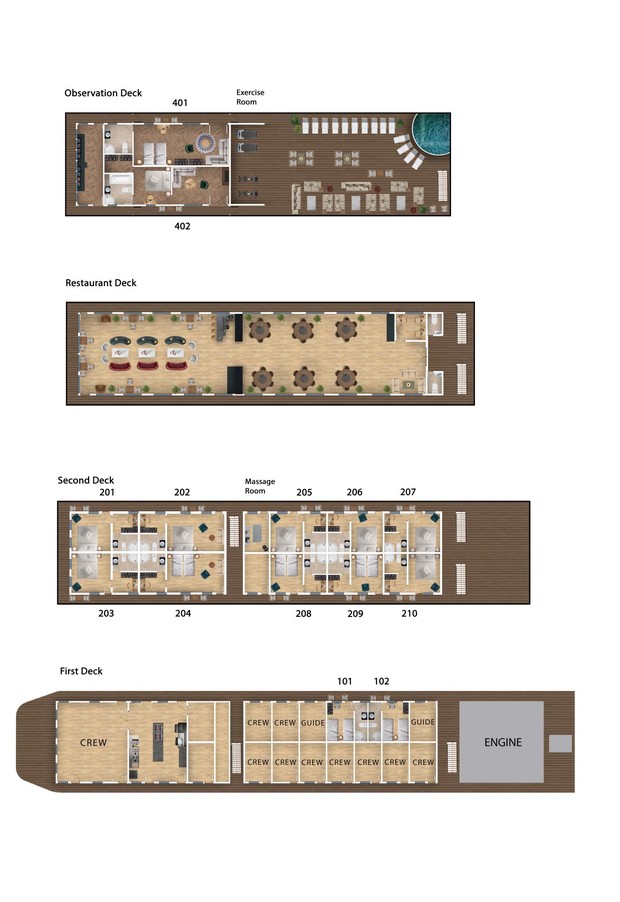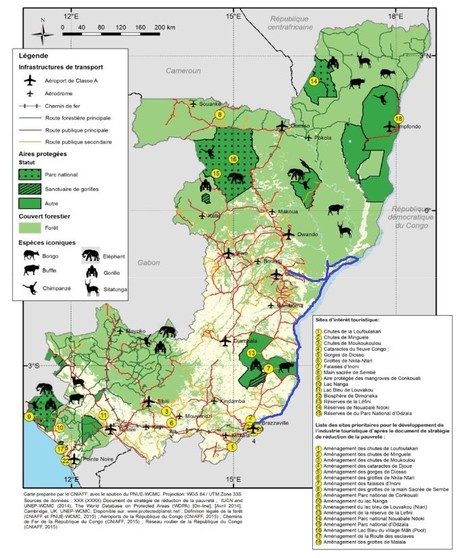HIGHLIGHTS OF THE CONGO CRUISE
- Navigation on the Congo River
- Observation of gorillas and hippos in the Lesio Louna sanctuary
- Bird watching on the river
- Landscapes of savannah and swamp forest
- Meeting the fishermen of the Sangha
- Discovery of traditional pharmacopoeia
- The Teke Kingdom and the Kebe-Kebe dance
- The Moye people
- Visit of Brazzaville and meeting with the sapeurs
- Native guides from Congo to accompany you
- Conferences on board to enrich the trip
- Small group travel to create bonds and not disturb ecosystems
- Travel that respects the environment and people
Availability is always subject to confirmation. Please check with us before booking flights
There are no future departures for this trip at this stage.
Arrival in Brazzaville. Our guide will be waiting for you at the airport to transfer you to the ship.
- Night on board.
In the morning, we set out to explore the city, The Congo Basin Museum, the Poto Poto School, the Cathedral and we end with a meeting with “La Sape” – Society of Ambiance-Makers and Elegant People. Then begin the long journey up the Congo River through a landscape of green hills. We take advantage of the first miles to get to know our guides and learn about the Congo.
- Night on board.
In the morning, we visit Ngabe, one of the ancient capitals of the Téké kingdom. We ascend through the village to visit the current queen. As the guardian of “Nkwembali,” the spiritual deity of the Batéké, she is the person authorised to transfer power to the new king, the Makoko. She holds significant influence in the Téké kingdom, one of the powerful kingdoms in the country.
After our lunch on board we return to the village to witness a kebe kebe ritual. It refers to a dance and an initiatory society of the Congo. The ordinary form of the kebe-kebe resembles whirling dervishes, wrapped in raffia robes set with feathers of various birds, and manipulating a puppet which generally represents a painted Koyo head exhibiting the particular scarifications of the ethnic group.
In the afternoon, we reach the estuary of the Lefini River, a popular spot for birds and hippos depending on the season. We leave the ship on launch boats to observe the majestic mammals. We return to the ship for lunch and continue our ascent.
- Night on board.
The Congo River widens considerably (more than 10 km) and a labyrinth of islands is formed. Fishing villages are established there during the dry season. In the estuary of N’keni, we will go for birding in the morning (bee eaters, weavers, egrets, kites).
From the observation deck, we watch the fascinating boats, whaleboats and long flat-bottomed transport barges that are pushed along the Congo River. Travelling for weeks at a time and measuring up to two hundred metres in length, these floating villages transport goods, people and livestock from town to town. They play a crucial role in the economy and life of the Congo River communities. If the weather permits, we will take the opportunity to bivouac on a sandbank in the middle of the myriad of islands.
- Night on board.
In the morning we set out to explore the city of Mossaka. Led by our local guide Jean de Dieu, we discover the remnants of the colonial era, we visit the bustling local market where we’ll immerse ourselves in the daily life of the local people. Our visit takes us through the alleys where salted fish dryers are installed. This traditional technique of preserving fish has made Mossaka famous throughout the region. We also discover the production of palm wine and meet a potter. We return to the ship for lunch and continue our navigation to Likendze.
At the village of Likendze on the Sangha River, we learn different fishing techniques such as cast net fishing, trap fishing, and net fishing. Those interested can even try their hand at line fishing.
- Night on board.
In the morning, we leave on launch boats to observe the hippos who live a few kilometres north of the village and we’ll go for a birding in search of the emblematic birds of the region such as ospreys, palm-nut vultures, African fish eagles, hamerkops, cormorans, kingfishers, weavers, ibis, grey herons, storks, egrets, hornbills, pied crows, Brazza’s Martin and the elusive turaco. Back on the ship, we navigate towards the Alima River. This beautiful narrow winding river is surrounded by swamp forests. We finish the day in the village of Bonda where we meet the Moye People. They are our guides to discover the flooded forest. Following the season, we discover the forest by canoe or on foot. In the evening, the Moye people perform a traditional dance on the bank of the river. At night, we will navigate in a 900 m loop to listen to the forest and perhaps, spot the shining eyes of the crocodiles.
- Night on board.
We navigate on the Alima River. Passing the many bends of the river, along the banks we can see many charming raffia villages. Later on, we reach the village of Mondongo. This village, also made primarily using raffia, is home to Moye People. We met a local guide who explains the traditional pharmacopoeia and the preparation of remedies. The swamp forest is teeming with plants the villagers use for traditional medicine to treat diseases and injuries.
In the afternoon, we reach a small tributary with black water where the locals call crocodiles to hunt them.
- Night on board.
We disembark and depart Oyo in the morning by car for a 4 hour drive to Imbalanga. After lunch at the campsite prepared by our cook, we walk to the observation platform about 500m from the camp. Loacted in the northeast of Odzala Park, the Imbalanga bai is a prime location for gorillas because of its abundance of cyperaceae and grasses, which they love. From our platform, if they are here, we can observe them. The young play, the females feed and others rest. The largest gorillas can measure up to 1.70 metres. Other animals such as collobus, duiker and sitatunga can be seen.
- Overnight in camp.
After enjoying the morning relaxing and wildlife viewing at the bai, we leave in the afternoon for Moba Pool (90 minutes by jeep). This small, round clearing in the forest has a pond in the middle where forest elephants often visit to freshen up and get minerals from the mineral-rich soil. Also possible to observe are bongo, bushpig and gorillas from the platform.
14h30 Departure for Moba pool (1h30 by car and 15mn walk)
17:30 departure for Imbalanga camp, arriving around 19:00
- Overnight at the camp.
We rise early in the morning. After a cup of coffee, we drive to the Platform of Moba Pool to observe. After our packed breakfast on the platform, we continue our exploration on foot for a 2-3 hour hike through the tropical forest to reach the Mambili River. We then embark on a motorboat to reach the Lokoué camp, where we have the chance to observe elephants, buffalos, monitor lizards, gharials and birds. After freshing up in the river and a packed lunch, we return slowly make our way back to Imbalanga camp.
4:45 Leave the camp for the 1h30 drive to Moba Pool + 15-minute walk
6-8:30 Observation on platform and breakfast
8:30-11:30 Botanic and observation walk in forest to the Mambili River
11:30-13.00 Navigation on the launch boat on Mambili River. Observations on the way. If we are lucky: elephants, buffalo, monitor lizards, false gharials, birds (kingfisher, eagle).
13-14.00 Lunch at Lokoué platform. Possibility of a swim in the river.
15.00 Return to Camp Imbalanga (1h30 navigation and 1h30 drive).
- Overnight in camp.
After a last visit on the platform we take our breakfast before driving about 5hr to Oya. we arrive in early afternoon, time to relax by the pool and enjoy a nice sundowner.
Lunch and dinner included
- Overnight in a resort on the Alima River.
We leave early in the morning for a 3.5hrs drive to the Lwsio Louna sanctuary.
Founded in 1999 the Apinall Foundation, and part of the Congolese gorilla protection program (PPG) Lesio Louna aims t orescue gorillas from wildlife trafficking or zoos which cannot tend to them and reintroduce them into their natural environment. On board a motorboat, we set off on the Louna River, which winds through the forest, witj the keepers to reach the islands where the gorillas live during the period of adaption to thier new life. As soon as they are able to feed themselves, they will then be released into the Park. After a memorable time close to these fascinating primates, we return to Brazzaville by car.
Night in 5* Hotel in Brazzaville
Transfer to Brazzaville Airport for your flight home
Princess Ngalessa

| Length | 52 Metres |
|---|---|
| Speed | 12 knots |
| CREW | 18, including a cruise director and 3 naturalist guides. |
The ship lwas built in a Belgian run shipyard in Kinshasa in 2017. It takes the form of the passenger ships that have for decades transported passengers on the Congo River and its tributaries between the different capitals of Central Africa. With a robust steel construction, she is powered by two new-generation 380 HP Caterpillar engines, thus reducing noise pollution and fuel consumption. Its draft of 90 centimeters allows it to navigate easily on shallow rivers.
In 2022/2023, she was refitted to launch the first 4* safari cruises in the heart of one of the most mysterious forests in the world, the Congo Basin forest. Its renovation into a comfortable 4-star Boutique Hotel Ship launches a new era for the development of sustainable tourism in the Republic of Congo (Congo Brazzaville).
In June 2023 she began the first cruises on the Congo and Sangha rivers, thus reviving the long tradition of river navigation in the Congo.
ON BOARD LIVING AND SOCIAL AREAS :600 m² of common areas
Dining room
Indoor bar and lounge
Outdoor lounge
Outdoor jacuzzi
Massage Room
Observation Deck
WORLD CLASS DINING PROGRAM
A culinary experience nourished by African and European influences
A menu specially prepared by a French Chef rewarded for his work with a Michelin star in 2021
Local products and fine wine.
LAUNCH BOATS FOR SHORE EXCURSIONS
Two auxiliary aluminum launch boats equipped with four-stroke low emission engines. Each boat has a capacity of 15 passengers.
Kayaks for two people
Accommodation
Passengers are accommodated in 14 Design cabins across three decks.
Owner’s Suite 35 m². Observation deck. Private balcony (9m²) :
Three windows, armchair, writing desk and chair, two bedside tables, sofa, and a closet. Bathroom. Air-conditioning. 1 cabin with two single beds that can convert to a queen. 1 cabin with one queen bed. (401, 402)
Forward Master Suite 23 m². Second Deck Forward. Public balcony :
Four windows, armchair, writing desk and chair, two bedside tables, and a closet. Bathroom. Air-conditioning. 2 cabins with queen beds. (201, 202)
Master Suite 27 m². Second Deck. Public balcony :
Three windows, armchair, writing desk and chair, two bedside tables, sofa, and a closet. Bathroom.Air-conditioning.1 cabin with two single beds that can convert to a queen. 1 cabin with one queen bed. (203, 204)
Deluxe Suite 18 m². Second Deck. Public balcony :
Two windows, armchair, writing desk and chair, two bedside tables, and a closet. Bathroom. Air-conditioning. 2 cabins with two single beds that can convert to a queen. 4 cabins with queen beds. (205, 206, 207, 208, 209, 210)
Classic Cabin 12 m². First Deck. Public balcony :
One window, armchair and a closet. Bathroom. Air-conditioning. 2 cabins with two single beds (101, 102)
Deck plans are for illustrative purposes only – The actual ship and cabin layout may differ.



